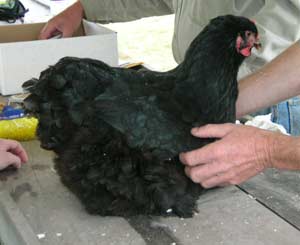Black Chicken Farming: A Profitable Venture
Brooding Cage (Raising Chicks from 1 to 5 Weeks Old)
 A brooding cage for 100 chicks should be 2 meters long, 1 meter wide, and 0.5 meters high. The cage should be elevated on legs that are 0.4 meters tall or 0.1 meters above the ground, with a floor made of square mesh with a size of approximately 1 cm2. Surround the brooding cage with bamboo, wood slats, or wire mesh. The stocking density should be 100 chicks per square meter from 1 day to 1 week old, 50 chicks per square meter from 1 to 2 weeks, and 25 chicks per square meter from 3 to 5 weeks.
A brooding cage for 100 chicks should be 2 meters long, 1 meter wide, and 0.5 meters high. The cage should be elevated on legs that are 0.4 meters tall or 0.1 meters above the ground, with a floor made of square mesh with a size of approximately 1 cm2. Surround the brooding cage with bamboo, wood slats, or wire mesh. The stocking density should be 100 chicks per square meter from 1 day to 1 week old, 50 chicks per square meter from 1 to 2 weeks, and 25 chicks per square meter from 3 to 5 weeks.
Care and Nutrition
Brooding Chicks (from 1 to 5 weeks old):
– Clean and disinfect the brooding area, feeders, and waterers 5-7 days before introducing the chicks. Line the brooding cage floor with newspaper for the first 3 days, changing the paper daily.
– Heating: Use a 75W bulb (or a large oil lamp) for every 1m2 of brooding space during the first week, and cover the surrounding area. Adjust the heating temperature during the brooding period: for chicks aged 1 day to 1 week, maintain a temperature of approximately 34-35°C; from 1 to 2 weeks, 30-31°C; from 2 to 3 weeks, 28-29°C; and from 3 to 4 weeks, 25-26°C. The room temperature for the brooding area should be maintained around 25-28°C both day and night.
– Provide water for the chicks immediately after placing them in the brooding area.
– Start feeding the chicks 2 hours after introducing them. For initial feeding, scatter crushed corn on the surface of the feeding tray or paper lining the cage. From the next day, provide a mixed feed, and start using a feeder from the 4th day.
Feed: Use 100% industrial feed for free feeding from day 1 until sale (5 weeks old), with the feed formulation containing: energy 2,950-3,000 Kcal, protein 22-24%, calcium 1%, phosphorus 0.53%.
Lighting: Turn on lights at night to encourage the chicks to eat more.
Disease Prevention
– Vaccination: At 3-5 days old, vaccinate against Newcastle disease + IB with 1 dose per chick, administered in the eye. At 7-10 days old, vaccinate against Gumboro disease with 1 dose per chick in the eye; from 10-12 days, vaccinate against fowl pox with 1 dose per chick administered intramuscularly; from 14-18 days, vaccinate against Gumboro disease with 1 dose per chick in the eye or orally; at 21 days, vaccinate against Newcastle disease + IB with 1 dose per chick in the eye. Only vaccinate healthy chicks. Provide water mixed with Polyvitamin, vitamin C, or electrolytes during vaccination.
– Disease prevention with medications and vitamins: From 1-4 days old, mix water with one of the following antibiotics: Tylosin 0.5g/liter, Chloramphenicol 0.2-0.3g/liter, Imequyl 0.5g/liter…
Prevent coccidiosis using one of the following medications: Anticoc, Avicoc, or ESB at a dose of 1g/liter at 10-13 days and 18-20 days old. Mix water with vitamins 3-5 days/week using one of these medications: Vitaperos 0.2g/liter, Solminvit 0.5g/liter, Vitalytes 0.75g/liter… Medications can also be mixed into feed at a dose that is double the concentration used for 1 liter of drinking water. When weather changes or moving chickens, add antibiotics and vitamins to the feed or drinking water for 3-5 days. Regularly monitor the flock’s condition to detect and treat diseases promptly. Stop using antibiotics one week before slaughter.


















































